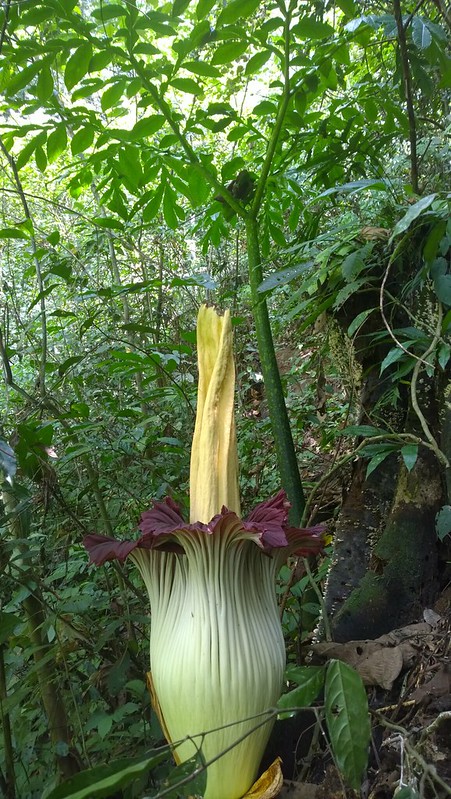Amorphophallus characteristics
Amorphophallus is a genus of flowering plants found across Asia, Africa, and Australia. The Latin name means 'formless penis', referring to the shape of the plant's inflorescence (cluster of flowers). Amorphophallus is part of the arum family, sometimes known as arum lilies (as distinct from true lilies, to which they are not closely related), which is a large family of flowering plants found across the world.
Amorphophallus inflorescences range in size from small, to the largest unbranched inflorescence in the world, which is the Amorphophallus titanum, found in the jungles of Sumatra, including in the Gunung Leuser national park.
Reproduction
The Amorphophallus starts life as a seed, from which a stem and leaf grow. The leaf captures energy from the sun by photosynthesis, which it stores in an underground tuber. After several months, the leaf and stem die back, and the tuber lies dormant. As the growing seasons go by, the size of the underground tuber grows larger. After several seasons of tuber growth, the plant may instead of a leafy stem, grow an inflorescence, which looks similar to a flower, but is actually a combination of male and female flowers, which are stacked vertically within the inflorescence, male flowers above female. All the nutrients and sugars to produce the flower are stored within the tuber, the result of previous growing seasons - the plant produces no leaves when it flowers.
In the case of Amorphophallus titanum, the underground tuber can grow to several metres in diameter, and 100kg in weight, being the largest tuber in the world. Other species may have much smaller tubers, some of which are consumed by humans as food.
When the inflorescence opens, a process which may take a week or so after initially emerging from the previously dormant tuber, the plant emits powerful odours, designed to attract pollinators. In the case of A. titanum, the odour is of rotting flesh, which gives A. titanum (as well as A. gigas, which has a similar smell) the name 'bunga bangkai' in Indonesian, or corpse flower. In English, foul-smelling flowers are known as 'carrion flowers', a description which also includes Rafflesia species. Some other species emit more pleasant aromas. In the case of the 'bunga bangkai', the pollinators are believed to be small carrion beetles, although the foul smells also attract flies and other insects.
The fertilisation sequence is as follows:
- first day of flowering - the female flowers are receptive to pollen, and pollinating beetles are trapped within the flower by the plant, so that they might fertilise the flowers with pollen carried from other Amorphophallus plants
- subsequent days of flowering - the female flowers are no longer fertile, and the beetles are able to climb up the plant, to where the male flowers are now emitting showering of pollen (this staged flowering within the inflorescence insures that there is no self-fertilization)
- after flowering - the beetles escape the inflorescence, and, now covered in pollen, head towards another flowering Amorphophallus inflorescence, where they will fertilise the plant. Hence, even though Amorphophallus flowerings are rare and expensive for the plant, it is necessary for two plants in the same area to be flowering at the same time for fertilisation to occur
- the spathe, or cover, covering the flowers begins to rot after around a week, leaving the stem on which the female flowers grow. If the female flowers were successfully fertilised with pollen from a different plant, then the flowers will grow into hundreds of berry-like fruit, an infructescence. Each berry contains two seeds. The berries may be dispersed by birds or other animals, to allow the plant to spread to a new patch of jungle.

Amorphophallus titanum, near Bukit Lawang. The inflorescence in the foreground has been open for approximately two days. The tall leafy stem in the background is a different A. titanum plant, in leaf.
Species found in Sumatra
Known Amorphophallus species found in Sumatra are:
- A. titanum - the 'titan' found across Sumatra, including near Bukit Lawang
- A. gigas (possibly a synonym for A. asper) - the 'giant' found in western Sumatra. Its flowers grow even taller than A. titanum, thanks to a tall stalk, up to 3 metres high, but the inflorescences themselves are smaller, at 'only' around 1 metre high.
- A. hirsutus - 'hairy', found in western Sumatra, a smaller species
- A. beccarii - 'Beccari's amorphophallus' (Beccari was the discoverer of A. titanum, hence this smaller species was named in honour of him)
- A. forbesii - 'Forbes' amorphophallus'
- A. gracilis
- A. manta
- A. muelleri - Mueller's amorphophallus